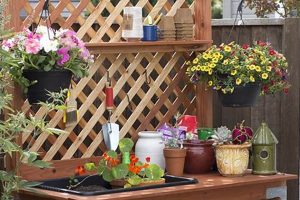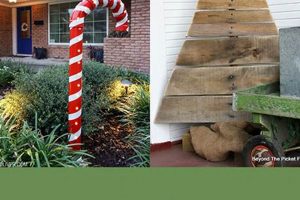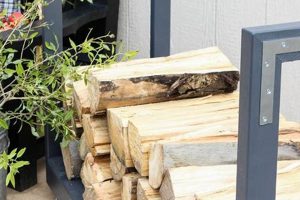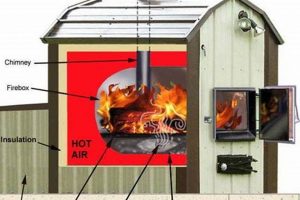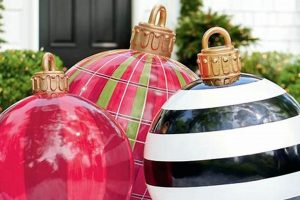A self-constructed enclosure designed to house and protect a television in an exterior environment. These structures provide a barrier against weather elements, physical damage, and potential theft. For instance, a homeowner might build such a unit to facilitate outdoor entertainment on a patio or deck.
Creating such a protective structure offers several advantages. It allows for extending the life of the television by shielding it from rain, sun, and temperature fluctuations, which can damage electronic components. Furthermore, constructing the unit offers customization in size, style, and material, allowing it to seamlessly integrate with existing outdoor decor. Historically, this type of project reflects a trend toward enhancing outdoor living spaces with indoor entertainment options.
The following sections will explore material selection, construction techniques, ventilation considerations, and security measures applicable to successfully undertaking this type of endeavor. Careful planning and execution are essential for a durable and aesthetically pleasing result.
Construction Guidance
The following guidance aims to optimize the creation of a protective housing for a television in an exterior setting. Adherence to these points will contribute to longevity and performance.
Tip 1: Material Selection is Crucial: Opt for weather-resistant materials such as cedar, redwood, or treated lumber for the frame. These woods exhibit natural resistance to rot and insect infestation. Metal components should be corrosion-resistant, like stainless steel or powder-coated aluminum.
Tip 2: Prioritize Ventilation: Adequate airflow is vital to prevent overheating. Incorporate screened vents at the top and bottom of the structure to promote convection. Consider a thermostatically controlled fan for enhanced cooling in warmer climates.
Tip 3: Implement Weatherproofing: Apply a sealant to all joints and seams to prevent water intrusion. A gasket around the television screen opening provides an additional barrier against moisture. Overhangs can also help to deflect rain.
Tip 4: Secure the Television: Utilize a robust mounting system specifically designed for outdoor use. Ensure the mount is securely fastened to the cabinet frame to prevent movement or dislodgement during windy conditions.
Tip 5: Conceal Wiring: Incorporate a conduit system to protect and conceal electrical wiring. This prevents damage from weather and pests, and also enhances the aesthetic appeal of the finished product. Use outdoor-rated electrical components and connections.
Tip 6: Consider Access and Maintenance: Design the structure with easily accessible panels or doors to allow for maintenance, cleaning, and cable management. Hinged access points are generally preferable.
Tip 7: Implement Security Measures: A locking mechanism is recommended to deter theft. Consider a recessed locking system that is difficult to tamper with. Reinforce the door or panel construction to resist forced entry.
Following these guidelines will improve the durability, functionality, and security of the custom-built outdoor television enclosure.
Subsequent sections will discuss aesthetic considerations and integration with the surrounding outdoor environment.
1. Weatherproof Material Selection
Weatherproof material selection constitutes a foundational element in the successful creation of a functional and enduring enclosure for a television in an outdoor setting. The external environment presents numerous challenges, including precipitation, ultraviolet radiation, temperature fluctuations, and potential insect infestation. These factors directly impact the longevity and operational integrity of both the cabinet structure and the television it houses. Inadequate material selection inevitably leads to premature degradation, structural compromise, and potential damage to the electronic components within.
The correlation is evident: utilizing materials inherently resistant to these environmental stressors extends the lifespan of the entire unit and minimizes maintenance requirements. For example, opting for cedar wood, renowned for its natural oils that repel insects and resist moisture, reduces the likelihood of rot and infestation, common issues with less suitable materials such as untreated pine. Similarly, employing stainless steel hardware mitigates corrosion, a frequent problem in coastal environments. Weatherproof material selection also dictates the overall aesthetic appeal and integration with the surrounding outdoor space. Coordinating materials to complement existing outdoor furniture or architectural elements enhances visual harmony and overall property value.
Ultimately, the careful consideration and implementation of appropriate weatherproof materials is not merely an aesthetic choice; it is a practical necessity for ensuring the resilience and enduring performance of an outdoor television enclosure. Neglecting this crucial aspect compromises the entire project, potentially resulting in costly repairs or premature replacement. Therefore, prioritizing material selection is paramount for achieving a sustainable and satisfying outcome.
2. Ventilation System Design
Ventilation system design constitutes a critical engineering consideration in the creation of a self-assembled outdoor television enclosure. The operational lifespan and reliability of electronic components, particularly a television, are intrinsically linked to temperature regulation. An enclosed environment exposed to direct sunlight and ambient heat requires a meticulously designed ventilation system to mitigate thermal stress and prevent component failure.
- Convection-Based Ventilation
Convection relies on natural air circulation to dissipate heat. Implementing vents at the bottom and top of the enclosure facilitates the upward movement of warm air, thereby drawing cooler air in from below. The efficiency of convection is influenced by vent size, placement, and the temperature differential between the interior and exterior of the cabinet. Insufficient convection results in heat buildup, potentially exceeding the operational temperature thresholds of the television.
- Forced Air Ventilation
Forced air systems employ fans to actively circulate air within the enclosure. This approach offers greater control over airflow and is particularly effective in environments with high ambient temperatures or limited natural airflow. Fan selection necessitates careful consideration of airflow rate (CFM), noise level (dB), and power consumption. Thermostatic control can automate fan operation, activating it only when internal temperatures exceed a pre-defined threshold, optimizing energy efficiency and minimizing noise.
- Passive Cooling Techniques
Passive cooling methods supplement ventilation by reducing heat absorption and promoting heat dissipation. These techniques include utilizing reflective materials on the exterior of the enclosure to minimize solar heat gain, incorporating insulation to retard heat transfer, and employing heat sinks to draw heat away from critical electronic components. Integration of passive cooling can significantly reduce the burden on the ventilation system, particularly in climates characterized by intense solar radiation.
- Environmental Sealing and Filtration
While adequate ventilation is critical, preventing the ingress of moisture, dust, and insects is equally important. Ventilation openings should be screened with fine mesh to prevent particulate matter and insect intrusion. Consideration should be given to the orientation of vents to minimize exposure to prevailing winds and precipitation. A balance must be struck between maximizing airflow and minimizing environmental contamination to ensure the long-term reliability of the enclosed television.
The integration of a well-designed ventilation system, encompassing convection, forced air, passive cooling, and environmental sealing principles, is paramount for maintaining optimal operating temperatures within a self-built outdoor television housing. Neglecting ventilation design can result in overheating, component degradation, and premature television failure, underscoring its importance in ensuring long-term performance and reliability.
3. Secure Mounting Hardware
The integration of secure mounting hardware is a non-negotiable element within the domain of self-assembled outdoor television enclosures. The direct correlation between the quality and robustness of the mounting system and the longevity and safety of the installation is undeniable. Environmental factors such as wind, rain, and temperature fluctuations exert constant stress on the structure, demanding a mounting solution capable of withstanding these forces. The omission or underestimation of this requirement can precipitate catastrophic failures, resulting in damage to the television, the enclosure itself, and potentially causing injury to individuals in the vicinity. As a concrete example, consider a coastal region where sustained high winds are prevalent. A poorly secured television, subjected to these forces, may break free from its moorings, creating a hazardous projectile.
The selection of appropriate mounting hardware necessitates a thorough assessment of the television’s weight, dimensions, and mounting point specifications, typically conforming to VESA standards. The chosen hardware must possess a weight rating exceeding the television’s mass to provide a margin of safety. Furthermore, the hardware’s composition should be resistant to corrosion, with stainless steel or powder-coated aluminum being preferred materials. Installation practices must strictly adhere to manufacturer guidelines, ensuring proper anchor placement and torque application. Field examples demonstrate that neglecting these procedures often results in loosened connections and eventual structural instability. Specific attention must be given to the substrate to which the mounting hardware is affixed. If mounting to wood, ensure the wood is structurally sound and of sufficient thickness to bear the load. If mounting to masonry, utilize appropriate anchors designed for that specific material.
In summation, secure mounting hardware is not merely an accessory but an integral component of a safe and durable self-constructed outdoor television cabinet. A comprehensive understanding of load capacity, environmental stressors, material properties, and proper installation techniques is paramount. A failure to prioritize these considerations jeopardizes the entire project, potentially leading to costly repairs, property damage, or, in the worst-case scenario, personal injury. Therefore, meticulous planning and execution in the selection and installation of mounting hardware are indispensable for ensuring the long-term viability and safety of an outdoor television installation.
4. Wiring Protection Strategy
A coherent and robust wiring protection strategy is an indispensable element in the successful implementation of a self-built outdoor television enclosure. The vulnerabilities inherent in exposing electrical wiring to the elements necessitate a comprehensive approach to safeguard against potential hazards and ensure operational reliability. The following points outline key facets of such a strategy, emphasizing the interplay between safety, durability, and performance within the specific context of an outdoor television setup.
- Conduit Selection and Installation
Conduit serves as the primary physical barrier, shielding wires from moisture, abrasion, and physical damage. The selection of appropriate conduit material, such as PVC or metallic conduit, depends on environmental factors and local electrical codes. Proper installation, including secure fastening and watertight connections, is crucial to maintain the integrity of the protective barrier. Neglecting this step can lead to water ingress, causing short circuits or corrosion.
- Weatherproof Connectors and Enclosures
Exposed electrical connections are particularly susceptible to corrosion and moisture damage. Employing weatherproof connectors and junction boxes designed for outdoor use is essential to prevent these issues. These components feature seals and gaskets that create a watertight barrier, protecting the connections from environmental elements. The proper installation of these connectors, ensuring tight seals and secure connections, is vital for long-term reliability.
- Ground Fault Circuit Interrupter (GFCI) Protection
A GFCI is a safety device designed to detect ground faults and quickly interrupt the flow of electricity, preventing electrical shock. Outdoor electrical circuits, including those powering a television, must be GFCI protected to mitigate the risk of electrocution in wet or damp environments. Proper installation and regular testing of GFCI outlets are crucial for ensuring their effectiveness.
- Cable Management and Strain Relief
Proper cable management prevents wires from becoming tangled, stressed, or damaged. Utilizing cable ties, clamps, and strain relief devices ensures that wires are securely routed and protected from physical stress. Neglecting cable management can lead to frayed wires, loose connections, and potential electrical hazards.
The effective implementation of these four facets conduit usage, weatherproof connectors, GFCI protection, and cable management collectively forms a comprehensive wiring protection strategy. The integration of these elements into the construction of an outdoor television enclosure serves not only to enhance safety and operational reliability but also contributes to the overall longevity and aesthetic appeal of the installation. A failure to address any of these aspects compromises the entire system, potentially resulting in hazardous conditions, costly repairs, or premature equipment failure.
5. Accessibility and Maintenance
The long-term viability of a self-constructed outdoor television enclosure hinges significantly on its accessibility for routine maintenance and potential repairs. An enclosure designed without adequate access provisions inevitably leads to difficulties in servicing the television, replacing components, or addressing wiring issues. This lack of accessibility increases the risk of damage during maintenance procedures and may necessitate partial or complete disassembly of the structure, thereby negating the initial cost-saving benefits of a do-it-yourself project. For instance, consider a scenario where a television requires a simple cable replacement; an enclosure with a fixed back panel would necessitate removing the entire unit from its mounting, potentially damaging the surrounding structure or the television itself.
Practical strategies to enhance accessibility include the incorporation of hinged doors or removable panels strategically positioned to provide unobstructed access to the television’s rear panel, power connections, and internal components. The selection of durable hinges and fasteners designed for outdoor use ensures the long-term functionality of these access points. Furthermore, designing the enclosure with sufficient internal space allows for ease of maneuvering during maintenance tasks. Examples include providing ample clearance around ventilation systems for cleaning and incorporating designated cable management channels to prevent wire entanglement. This approach not only simplifies maintenance but also reduces the risk of accidentally damaging components during service.
In summary, the integration of accessibility considerations into the design and construction of a outdoor television cabinet is not merely a convenience but a necessity for ensuring its long-term functionality and reducing the overall cost of ownership. By prioritizing accessible design, the project remains maintainable and adaptable to future needs, effectively mitigating the potential challenges associated with servicing electronic equipment in an outdoor environment. Neglecting this aspect can transform a seemingly cost-effective DIY project into a maintenance nightmare, ultimately undermining its intended benefits.
Frequently Asked Questions
The following questions address common concerns and misconceptions surrounding the design and construction of enclosures for televisions intended for outdoor use. These answers aim to provide clarity and guidance for individuals undertaking such projects.
Question 1: What materials are most suitable for constructing an enclosure designed to house a television in an outdoor environment?
Durable, weather-resistant materials are paramount. Options include cedar, redwood, treated lumber, and composite materials specifically designed for outdoor use. Hardware should be corrosion-resistant, such as stainless steel or powder-coated aluminum. The selection should prioritize longevity and resistance to environmental factors.
Question 2: How can adequate ventilation be achieved within an enclosure to prevent overheating of the television?
Effective ventilation strategies involve the integration of screened vents at the top and bottom of the enclosure to promote natural convection. In warmer climates, a thermostatically controlled fan may be necessary to augment airflow and maintain optimal operating temperatures. Careful consideration must be given to vent placement and airflow capacity.
Question 3: What measures can be implemented to ensure the security of a television housed within an outdoor enclosure?
Security measures should include a robust locking mechanism to deter unauthorized access. Reinforcing the enclosure’s door or panels with additional material can resist forced entry. Concealing the locking mechanism and utilizing tamper-resistant hardware further enhances security.
Question 4: How should electrical wiring be managed and protected within an outdoor enclosure?
Electrical wiring must be protected from moisture and physical damage through the use of conduit. Weatherproof connectors and junction boxes should be employed for all electrical connections. Ground Fault Circuit Interrupter (GFCI) protection is essential to prevent electrical shock in wet environments. Adherence to local electrical codes is mandatory.
Question 5: What considerations should be given to accessing the television for maintenance and repairs?
The enclosure design should incorporate easily accessible panels or doors to facilitate maintenance and cable management. Hinged access points are generally preferred. Sufficient internal space should be provided to allow for comfortable maneuvering during service procedures.
Question 6: Is specialized knowledge or expertise required to successfully construct a functional outdoor television enclosure?
While a basic understanding of carpentry and electrical wiring is beneficial, careful planning, attention to detail, and adherence to established guidelines can enable individuals with moderate DIY skills to undertake such projects. Consulting with experienced professionals is recommended for complex installations or electrical work.
The preceding questions highlight key factors to consider during the planning and construction phases. Successful projects require meticulous attention to detail and a commitment to safety and durability.
The subsequent section will delve into design considerations and integration of the enclosure with the surrounding outdoor environment.
Conclusion
The preceding exploration of diy outdoor tv cabinet construction has illuminated essential elements pertaining to durability, safety, and functionality. Material selection, ventilation design, security implementation, wiring protection, and accessibility have been identified as critical determinants of a successful project. Thorough consideration of these factors ensures the longevity and safe operation of the enclosed television.
The construction of a protective structure for outdoor entertainment necessitates diligent planning and execution. Individuals undertaking this endeavor should prioritize adherence to best practices and relevant safety standards to safeguard their investment and ensure a secure and enjoyable outdoor viewing experience. Future developments in materials and construction techniques will likely further enhance the capabilities and durability of these enclosures.


